As a custom webbing manufacturer, we regularly help brand manufacturers and product developers select optimal elastic wristband materials for their products. This guide addresses common challenges around material selection, durability requirements, and customization costs to help you make better design decisions through our tailor-made manufacturing expertise.
Elastic wristbands are flexible, circular bands made from elasticized webbing materials that provide consistent tension, comfort, and durability for wearable applications. These specialized bands utilize technical elastic fibers combined with supporting materials like polyester, nylon, or cotton to create products that maintain elasticity while resisting environmental factors and repetitive stretching during extended use periods.
Gain insights on material performance, avoid design failures, and learn how customization affects cost and lead time for better manufacturing outcomes.
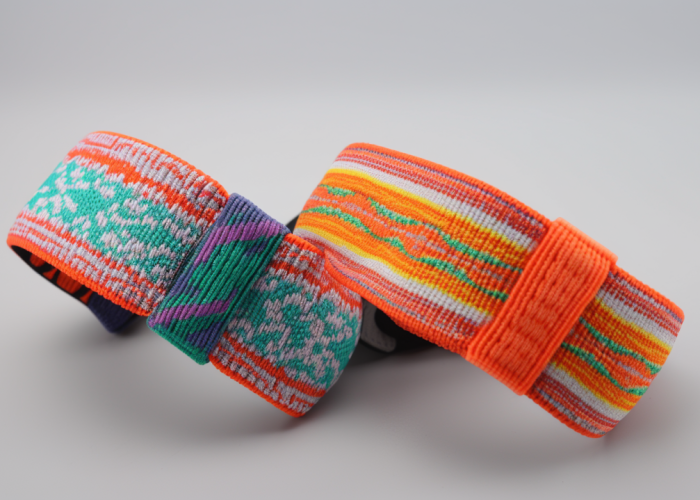

Webbing manufacturing expert with 15+ years of experience helping product developers build high-performance straps for industrial, medical, and outdoor use.
Silicone, natural rubber, and synthetic fibers (nylon/polyester) are the primary materials used in elastic wristbands, each offering distinct manufacturing characteristics and performance profiles. Material choice determines production methods, customization options, and regulatory compliance requirements.
Key Material Options:
From manufacturing experience, silicone enables injection molding with precise branding and complex shapes. Natural rubber uses simpler cutting and assembly processes for basic designs. Synthetic fiber construction utilizes standard weaving equipment, offering flexibility in patterns and textures.
Industry standards govern material safety and performance requirements. REACH compliance ensures chemical safety for European markets, OEKO-TEX Standard 100 validates textile safety, and FDA-grade silicone meets medical device requirements for healthcare applications.
Design Takeaway: Select material based on your performance requirements, customization complexity, and target market compliance needs. Each material offers distinct manufacturing advantages for different application priorities.
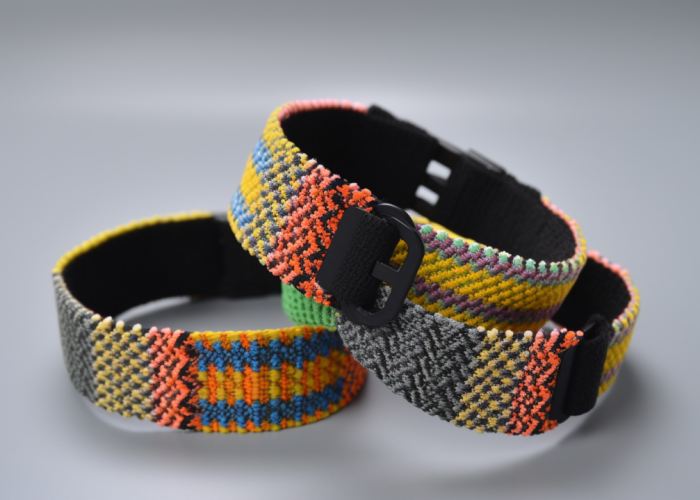
Tensile strength, elasticity retention, and environmental resistance are the primary factors determining elastic wristband durability. High-quality wristbands maintain structural integrity through repeated stretch cycles while resisting degradation from UV exposure, moisture, and temperature fluctuations.
Key Durability Metrics:
Industry testing follows ASTM D412 for tensile properties and ASTM D1149 for ozone resistance. Environmental stress testing reveals that untreated natural rubber loses 25-40% tensile strength annually under outdoor conditions, while UV-stabilized silicone maintains performance over 5+ years. Quality control includes batch testing for consistency and accelerated aging protocols to predict long-term performance.
Material degradation patterns show predictable failure modes: natural rubber develops surface cracking and hardening, while low-grade silicone exhibits tearing at stress concentration points. Proper material selection and design geometry prevent premature failure.
Design Takeaway: Specify minimum tensile strength requirements based on expected loads, require UV stabilization for outdoor use, and request accelerated aging test data to validate durability claims for your application timeline.
Printed/embossed silicone bands, fabric elastic bands, and braided/knitted/woven elastic represent the three main construction types, each offering distinct aesthetic capabilities and performance characteristics. Construction method determines final product feel, appearance options, and structural properties.
Construction Types:
Manufacturing capabilities differ significantly by construction type. Silicone molding handles complex 3D shapes and precise dimensional control with multi-color effects. Fabric construction enables photographic-quality printing and soft hand-feel characteristics. Braided elastic offers maximum stretch variability through fiber selection and construction tension.
Production characteristics vary by method: silicone provides precise tolerances and weather resistance, fabric delivers comfort and visual appeal, while braided construction maximizes stretch ratios and breathability. Each construction suits different aesthetic requirements and performance priorities.
Design Takeaway: Choose silicone for precise branding and durability requirements, fabric for comfort and complex graphics, or braided construction for maximum stretch and breathability. Construction type should align with your product’s primary performance and aesthetic objectives.
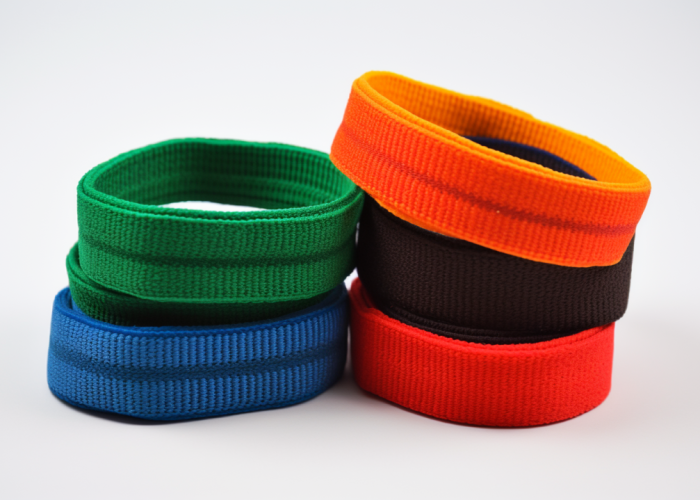
Silicone wristbands are optimal for multi-day events requiring durability and security, while fabric bands suit single-day events prioritizing comfort and visual appeal. Event-specific requirements like weather exposure, security needs, and duration determine the most effective material choice.
Event Application Matching:
Event duration directly impacts material selection economics. Multi-day events justify silicone’s premium cost through reduced replacement needs and enhanced security features. Single-day events maximize cost-effectiveness with fabric or synthetic alternatives while meeting comfort and branding objectives.
Security considerations include closure strength (silicone: 15-20 lbs vs fabric: 8-12 lbs), tamper-evidence features, and unique identification capabilities. Custom branding options vary by construction: silicone enables debossed text and color fills, while fabric supports full-color photographic reproduction.
Event-specific compliance includes CPSIA for family events with children and fire retardancy requirements for certain venues. Always verify local regulations early in planning.
Design Takeaway: Match material durability to event duration, prioritize security features for access control applications, and confirm venue-specific compliance requirements before finalizing specifications.
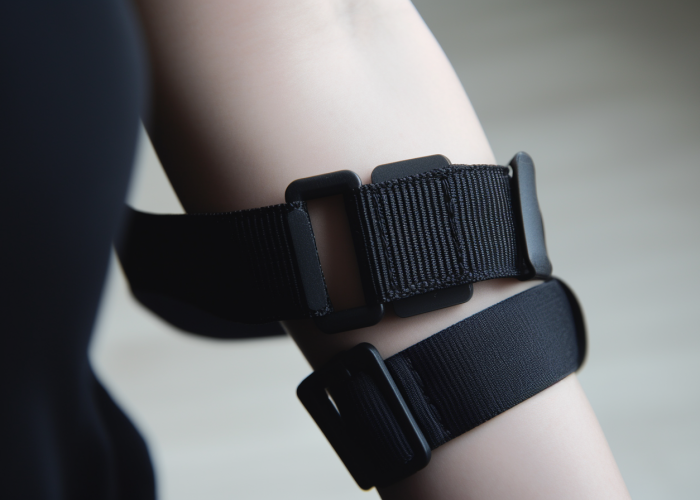
Material fatigue, overstretching, and environmental damage are the primary causes of elastic wristband failure, with most breakages preventable through proper material selection and design optimization. Understanding failure modes helps product developers avoid costly redesigns and customer complaints.
Common Failure Modes:
Manufacturing defects account for 15-20% of premature failures, including insufficient cure times in silicone, contamination during production, or improper fiber orientation in woven constructions. Quality control measures like tensile testing, visual inspection, and batch sampling help identify defective products before shipment.
User behavior significantly impacts failure rates. Excessive stretching during application, exposure to sharp objects, and chemical contact (lotions, sanitizers) accelerate degradation. Design considerations like rounded edges, appropriate wall thickness (minimum 1.5mm for silicone), and stress-relief features reduce user-induced failures.
Preventable failures include undersized bands causing overstretching, inadequate UV stabilization for outdoor use, and poor closure design leading to stress concentration. Unavoidable factors include normal wear, chemical incompatibility, and extreme temperature exposure beyond material limits.
Design Takeaway: Specify appropriate safety factors (2:1 minimum for working loads), avoid sharp geometric transitions, and include UV stabilizers for outdoor applications. Request failure mode analysis from manufacturers to optimize design geometry and prevent common breakage patterns.
Custom elastic wristband costs range from $0.05-2.50 per unit depending on material type, customization complexity, order quantity, and production timeline. Understanding cost drivers enables effective budgeting and value engineering for optimal project economics.
Primary Cost Factors:
Manufacturing process complexity significantly impacts pricing. Simple cut-and-print operations on existing materials minimize costs, while custom silicone molding requires tooling investments of $500-2,000 that amortize over production quantities. Fabric printing setup costs $100-300 per design but enables complex graphics and photographic reproduction.
Setup costs include tooling, artwork preparation, and production line configuration. Minimum order quantities typically range from 100 units for fabric construction to 500-1,000 units for custom silicone molding. Lead times extend from 10-14 days for standard materials to 3-4 weeks for custom formulations or complex tooling.
Value engineering opportunities include standardizing on existing mold designs, optimizing packaging for shipping efficiency, and combining multiple colorways in single production runs. Early collaboration during design phase enables cost-effective material substitutions and manufacturing process optimization.
Design Takeaway: Budget $0.15-0.50 per unit for standard customization, $0.50-1.50 for complex designs requiring tooling. Plan 3-4 week lead times for custom work and consider value engineering consultation to optimize costs without compromising performance requirements.
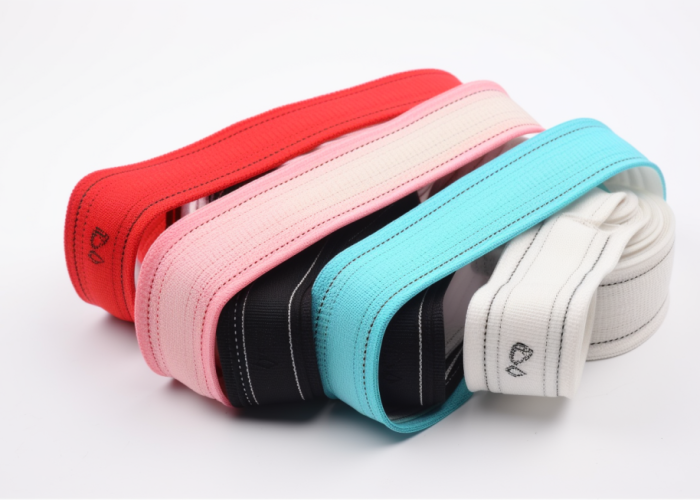
Elastic wristband material selection directly impacts durability, cost, and user satisfaction for your product applications. Silicone offers superior longevity for demanding uses, while fabric and natural rubber provide cost-effective solutions for specific requirements. Contact us to explore manufacturing solutions tailored to your elastic wristband requirements.
Silicone molding achieves ±0.1mm dimensional accuracy, while fabric construction typically maintains ±0.5mm tolerances on width and thickness. Specify critical dimensions and tolerance requirements during design phase to ensure manufacturing capabilities meet your product specifications.
Minimum order quantities range from 100 units for fabric bands to 500-1,000 units for custom silicone designs. Standard configurations with existing specifications often have lower minimums, while complex custom requirements may need higher quantities for efficient production.
Avoid sharp corners, maintain minimum 1.5mm wall thickness for silicone, and specify safety factors of 2:1 for expected loads. Request failure mode analysis during design review and include stress-relief features at closure points to prevent concentration failures.
Silicone wristbands are naturally waterproof and suitable for swimming, while fabric bands absorb water and natural rubber can degrade with repeated water exposure. For aquatic applications, specify silicone construction with secure closure mechanisms rated for water immersion.
Silicone wristbands last 3-5 years under normal use, while natural rubber degrades within 6-12 months and fabric bands typically last 1-2 years. Silicone’s superior UV resistance and chemical stability make it the most durable option for long-term applications.
US markets require CPSIA compliance for children’s products, European markets need REACH certification, and medical applications require FDA-grade materials. Specify required certifications early in development as they impact material selection and testing requirements.